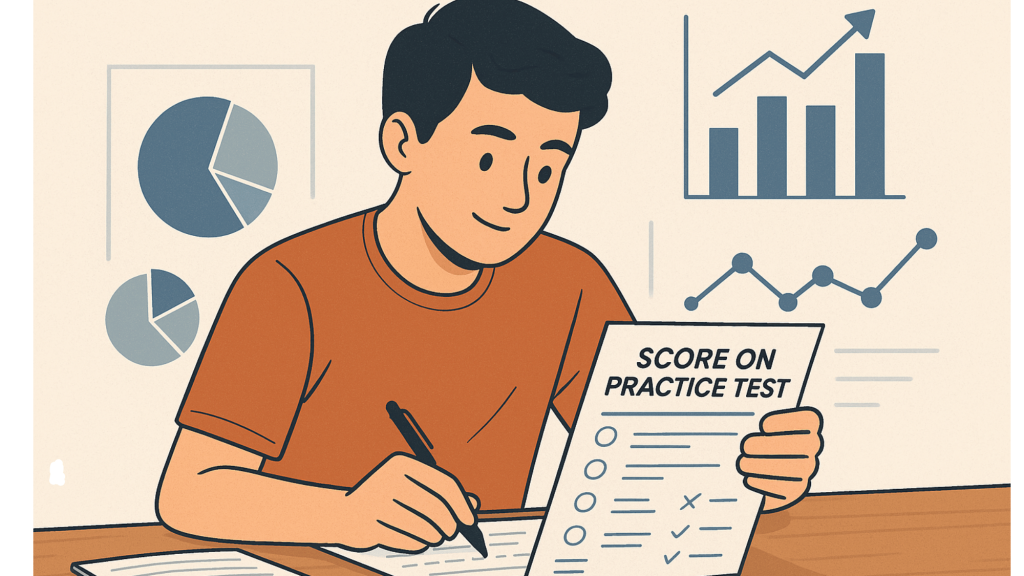
When preparing for any major exam, practice tests often feel like rehearsals before the big performance. Many students focus only on the number they get at the end, but the score on practice test is far more than a pass or fail indicator. It is a diagnostic tool that, when interpreted correctly, can shape your entire study strategy, sharpen your test-taking skills, and predict your real exam outcome with surprising accuracy.
In this article, we’ll explore five key insights you can deduce from the score on practice test. Each one helps transform your preparation from blind memorization into targeted, effective learning.
1. A True Snapshot of Your Knowledge Base
The most immediate takeaway from the score on practice test is where you currently stand in terms of subject mastery. Unlike casual revision or class assignments, practice tests are structured to mimic the real exam’s format, level of difficulty, and time pressure. That means the score you earn is a realistic reflection of how much content you have internalized.
If your score is close to or above the target benchmark, it signals readiness, but if you fall short, it’s not a reason for discouragement. Instead, it’s a wake-up call. The score on practice test offers a baseline against which all future progress can be measured. Think of it as your academic GPS—it shows your current location so you can chart a clearer path toward your goal.
2. Clear Identification of Strengths and Weaknesses
A deeper look at the breakdown of your practice test reveals much more than the overall score. Section-by-section results highlight your strong areas and expose the weaker ones. For instance, a student preparing for a nursing entrance exam may discover high performance in biology but consistent struggles in chemistry.
This diagnostic insight allows you to reallocate study time intelligently. Instead of reviewing everything with equal intensity, you can double down on weaker areas while maintaining strengths. In this sense, the score on practice test is not just a number—it is a map of where your attention should go next. Students who act on this information often find their scores improving more rapidly because their effort is concentrated where it truly matters.
3. Evaluation of Time Management
Time pressure is one of the biggest challenges in standardized tests. A score on practice test often reveals whether poor time management is holding you back. For example, a low score may not necessarily mean lack of knowledge—it could mean you spent too long on early questions and had to guess on the final section.
By analyzing your score alongside the time taken per section, you gain actionable feedback. Did you rush through easy questions? Did you run out of time and leave items unanswered? These patterns become obvious when the raw score is paired with timing data. Adjustments like setting mini-time goals per section, skipping and returning to hard questions, or practicing with a stopwatch can significantly improve the final outcome
4. Testing the Effectiveness of Your Strategy
Every test taker develops strategies, whether consciously or not. Some guess strategically, some eliminate wrong answers, others reread questions multiple times. The score on practice test acts as a litmus test for how effective those methods are.
For example, if you guessed on five questions and got four wrong, it may be time to refine your elimination strategy. If double-checking consumed time and did not improve your accuracy, maybe your instinctive answers are more reliable than you thought. In this way, each practice test becomes an experiment, and the score provides the result. Over time, you can refine your methods until you find the strategies that maximize both accuracy and speed.
5. Measuring Progress and Building Confidence
Perhaps the most powerful insight from the score on practice test is progress tracking. A single score may be discouraging, but a series of scores over time tells a different story. If your first attempt was 60%, your second 70%, and your third 78%, the upward trend proves your preparation is working, even if you haven’t yet reached the benchmark.
This perspective prevents burnout and boosts confidence. Students who measure progress instead of obsessing over one result tend to stay motivated longer. Moreover, by comparing scores across multiple tests, you can predict your likely performance on the actual exam. Psychologists call this “formative assessment,” and it is widely regarded as one of the most effective learning practices.
Conclusion
The score on practice test is not a random number or an arbitrary hurdle. It is a rich source of information that reflects your knowledge base, pinpoints strengths and weaknesses, evaluates time management, tests strategy, and tracks progress. When you treat practice test scores as diagnostic tools rather than final judgments, they become stepping stones to real success.
So, the next time you sit for a practice exam, don’t just celebrate or mourn the number at the end. Study it. Learn from it. Use it to refine your preparation. With every score on practice test, you are gathering the insights needed to face the real exam with confidence and precision.